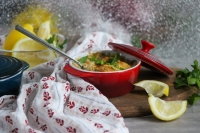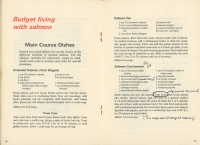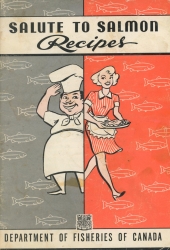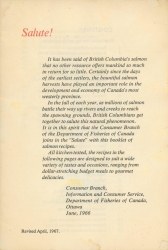
 604 465 4322
604 465 4322General Store Site 12294 Harris Road Pitt Meadows, B.C.
Click Here for Directions& Visiting Hours

Salmon Continental 1967
Recipe
1 can (15 1/2 ounches) pink salmon
2 hard-cooked eggs, quartered
1 cup cooked peas (Canned is okay!)
2 tablespoons chopped onions
2 tablespoons butter
2 tablespoons flour
1/4 cup milk plus salmon liquid
1 can (10 ounches) cream of celery soup
1/2 cup mayonaise
Few grains cayenne
1/8 teaspoon pepper
1/2 teaspoon curry powder
1/2 teaspoon paprika
Drain salmon and save the liquid. Crush bones (removed the bones!) and break salmon into chunks. Spread salmon, eggs and pease in a greased shallow 9x6 inch baking dish. Saute the onion in butter for 2 to 3 minutes, then stir in flour, milk and salmon liquid. Stir until thick and smooth. Add remaining ingredients and seasonings. Spoon sauce over salmon. Sprinkle with paprika and bake in a moderately hot oven (400 degrees Fahrenheit),for 20 minutes of until bubbly.
Makes 5-6 servings. (This recipe was a bit strange but tasted okay)
This recipe comes from the "Salute to Salmon" cookbook created by the Canadian Department of Fisheries in 1967.
*****
In the fall of each year, the salmon travels upstream to reach the spawning ground, lays their eggs, then the adult salmon dies, leaving room for the new life cycle to begin again. Quite poetic in its actions, the salmon symbolizes a lot more than the metaphor behind life. Salmon has played an essential role in Canada’s cultural, economic, and ecological aspects. Salmon has been a crucial resource for Indigenous cultures for thousands of years, making it a critical food source. With salmon rich in protein, healthy fats, and essential vitamins and minerals, the fish was often harvested and preserved to sustain people throughout the harsh winters. Indigenous cultures also celebrate the salmon, recognizing the sacrifices it makes and furthering the spiritual and cultural connection with the land and all living things. Salmon also plays a vital role in maintaining our ecosystems. As they migrate upstream, they transport nutrients from the ocean to freshwater systems, promoting the growth of other species. Unfortunately, salmon face life-threatening changes due to overfishing, climate change, and habitat destruction. To alleviate the threats, conservation efforts are underway to protect and restore salmon populations, habitats, and fishing regulations. Connecting with Indigenous communities towards conservation would prove beneficial due to their vast knowledge, which was passed down from generation to generation regarding seasonal patterns, habitat requirements, and harvesting methods. The sustainability of salmon affects all communities, so conservation and protection of the species are vital for salmon to remain a crucial resource for Canada.
The 1960s proved to be a challenge to Canada’s fisheries. Embroiled within an overfishing crisis, fish stocks were declining, and many species were on the brink of collapse. The development of sonar and radar made detecting fish species easier to locate and catch but contributed considerably to overfishing. During this decade, the Department of Fisheries Canada’s main goal was to promote the commercial fishing industry and increase the export of fish products. These practices led to the implementation of sustainable fishing practices and regulations because of the growing concern about the impact of industrial pollution and overfishing on Canada’s fisheries and aquatic ecosystems. The 1960s also brought significant tensions to the country’s fishing systems. Increased competition, mainly with Japan and the Soviet Union, started pressures regarding fishing rights and territorial waters, ultimately ending with Canada taking steps to secure its sovereignty towards fishing. Although faced with many challenges, the fishing industry remained a significant contributor to Canada’s economy, supporting thousands of jobs and generating billions of dollars in revenue.
The 1960s were a transformative decade for Pitt Meadows. With the population growth rising to 2,225 residents by 1966, the use of agricultural land had started to change, such as developing the Pitt Meadows Golf and Driving Range beside Lougheed Highway in 1960, the building of the Pitt Meadows Golf Course in 1963 on the land that used to be the Greybrook farm, and a new airport built on farmland during the same year. 50 years of Pitt Meadows was celebrated in 1964, and to honour the celebration, a portable stage was constructed for the Miss Pitt Meadows Day celebrations. Until recently, the stage was used at Harris Road Park but was taken down due to age and rot. Another project to honour the 50th anniversary was developing a design for the city crest. Records of the entries were held at District Hall but were passed down to the Museum. The current crest was not part of the contest but was developed later in the decade by Norm Shearing, crediting him to Pitt Meadows’ motto, “Prosperity Through Endeavour.” The crest’s creation date is still unknown, but records make it known that the crest began to appear on city letterhead in the 1970s, and orders of items bearing the crest in 1976. The final anniversary project was a community history book. Edith McDermott, the former Pitt Meadows Elementary principal, took on the research for the book but sadly passed away before her work could be published. The research and completion of the book were taken on by the community, and it was published in 1967 for Canada’s centennial year. The book was reprinted in 1997, 2006, and lastly 2014.
The Salute to Salmon cookbook by the Department of Fisheries Canada highlights the importance and impact of salmon on the fishing industry’s economic and ecological aspects. The cookbook, created in 1967, varies in recipes that cater to people of all economic backgrounds. From budget meals to gourmet delicacies, this cookbook emphasizes the desire to incorporate salmon into everyday life. Although the fishing industry brought many advancements and development to our country, it is crucial to focus on the cultural significance of the fish. Embedded in traditions and respecting the species' life that has fueled and nourished generations, Indigenous people knew the power salmon held. Acknowledging and honouring what came before them and what comes after. So taking the poetic actions of the salmon’s life cycle and applying them to our own lives, let us forge our own path, always swim forward, and accept change as it comes to better ourselves and the generation in waiting.

Salmon Continental 1967

Recipe for Salmon Continental from 1967

Salute to Salmon Cookbook from 1967

Foreward from the Salute to Salmon Cookbook 1967





